The Flame Angelfish (Centropyge Loricula) is one of the most attractive of all available marine angelfish. It has a bring orange-red coloration topped by a vertical elongated black spot and five stripes on each side with alternating shot blue and black stripes.
Table of Contents
An angelfish from the Great Pacific
The flame angelfish can be found in the East of the Indo-Pacific, from Australia and New Guinea to the Hawaii Islands. It frequents the lagoons and the calm reef areas, remaining close to the soil, with the possibility to sneak into the security holes of the rocks and corals. It is present from the surface to a depth quite crucial for a coral fish (57 m). We rarely see him living in banks, most often we meet him alone, looking for food in the substrate and squeezing through the coral.a
In its natural habitat, the flame angelfish has a diet of algae and crustaceans. Usually, the lifespan of the flame angelfish is about 5-7 years or longer if they are kept in right conditions.
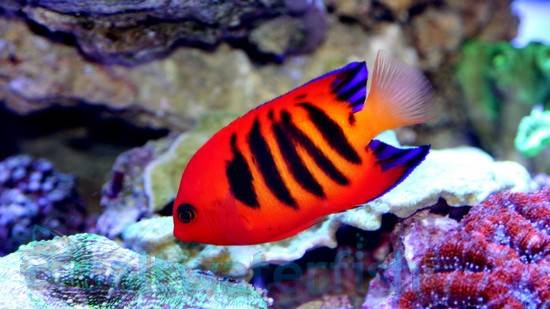
Flame Angelfish Overview
This species is only found in Australia and Hawaii Island in the Indo-Pacific Ocean’s east. The Flame Angelfish is a bottom-dwelling fish that prefers to remain close to the ground.
They live in harems of three to seven individuals, withdrawing to rocks and stony corals for shelter from predators. It’s something that home aquarium owners can simply replicate.
These fish are found in depths ranging from 18 to 80 feet. A 70-gallon tank can offer them plenty of space to roam about in.
Lemonpeel Angelfish, Queen Angelfish, and potentially Shepard’s Pygmy Angelfish have all been known to hybridize with them. It is possible to breed them in captivity, but it needs so many resources that it is generally not worth it for many fishkeepers.
Information Chart
| Information Chart | Flame Angelfish |
| Scientific Name: | Centropyge loriculus |
| Family: | Pomacanthidae |
| Care Level: | Easy to moderate (good fish for beginner aquarists) |
| Lifespan: | 5 – 7 years or longer if the required conditions are met |
| Size: | Up to 10 cm (about 4 in) |
| Diet: | Omnivore |
| Minimum Tank Size: | 30 gallons |
| Temperature: | 25°C – 27°C (75°F – 80°F) |
| Water Conditions: | pH: 8.1–8.4, Salinity: 1.020 – 1.025, Water Hardness: 8 – 12 dKH |
| Tank Mate Compatibility | Semi-aggressive |
Flame Angelfish Appearance
The Flame Angelfish gets its name from its blazing red skin, which resembles a real flame in a marine aquarium.
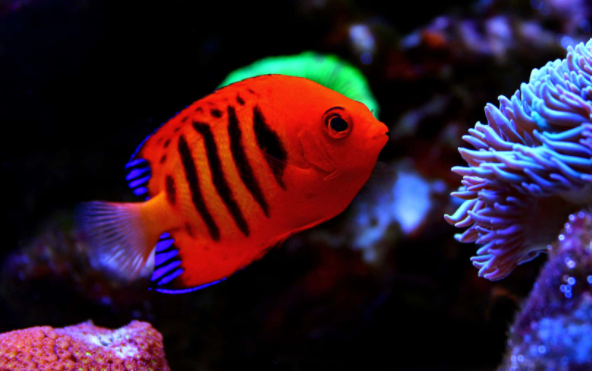
Their body is formed like a discus and has well-rounded fins. The coloring ranges from reddish-orange to deep orange. You might see a large patch on the back of their skulls in some circumstances.
They usually have three to seven vertical black stripes, which can be thick or thin, which serve as a distinguishing feature. Their pupils are dilated, and black—black lines with a bluish-purple tinge run around the back borders of the anal and dorsal fins.
Under the appropriate lighting circumstances, their pectoral and tail fins have an orange hue and seem to be a little transparent. Like with the remainder of their body, their pelvic fins are rich orange red.
The specimens’ geographical origins determine the Flame Dwarf Angelfish’s colors and patterning. Marquesas typically lack the black vertical stripes but have a large black patch behind their skull.
Specimens from Hawaii exhibit the most vibrant orange color of any other region. Micronesians have a yellow tint throughout their bodies, red-hued fins, and somewhat faded black bands.
Lifespan Of Flame Angelfish
The typical lifespan of a flame angelfish is 5 to 7 years. But they can live even longer. In the wild, their life expectancy is unknown.
Flame Angelfish Size
Males are also slightly larger than females, reaching 6″ or more in the wild. The typical Flame Angelfish is never more than 6 inches long.
Unfortunately, knowing the fish’s gender isn’t helpful for breeding. The parameters are far too specific to be replicated in a home aquarium.
Natural Habitat and Origin of Flame Angelfish
It can be found on Oceania’s reefs, with the Marshall, Line, and the Cook Islands being the most abundant. However, the fish can also be spotted in the Hawaiian Islands in smaller numbers. Flame angelfish can be observed on the fore slope of coral reefs and clear lagoons in particular.
Flame Angelfish Care and Tank Set-Up
This Centropyge deserves its common name. Indeed, it is like a real flame that illuminates a reef aquarium. Its brilliant colors make this fish a favorite kind of amateur aquarium, mingling among the many shades of the coral.
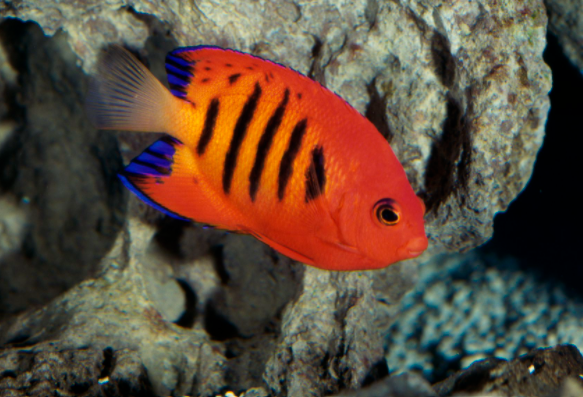
It requires a large and mature aquarium. It needs living stone because it is looking for food, so it is recommended that these fish be introduced into an aquarium at least six months of age. It requires more fissures and caves in which to retreat. Although there is no threat to the coral, it is good to be careful because they can harm them. They may be territorial or even aggressive with members of their species.
The flame angelfish is, therefore, a pearl for the reef basin. Not only does it have a superb color, but it also has a peaceful character towards other fishes with which it cohabits—only its congeners or Centropyge with similar colors (C. bispinosa, C. potters, etc.) risk aggressive.
Flame Angelfish Tank Size and Specifications
Your ultimate goal is to recreate the Flame Dwarf Angelfish’s native environment. It is not difficult to do besides the flame angelfish tank size of at least 70 gallons.
Optimum Tank Size for Flame Angelfish
Some experts claim that the fish will thrive in a 45-gallon tank, but we’d rather be safe than sorry. The Flame Angelfish requires a large swimming area and has an inquisitive nature. It’d be ideal if you had a large tank to keep it happy.
A tank of 200 liters is necessary for this fish to evolve normally. The decoration should be composed of living rocks that will facilitate its access to food and remove any inconvenience when a beginner aquarist encounters an obstacle in feeding this fish. Numerous hideouts and trails are arranged in decor as a security measure. It is important to note that this fish is sensitive to nitrates, which can cause certain skin diseases.
They will become territorial and highly competitive against other algae in a smaller tank.
Water Parameters for Flame Angelfish
Water Temperature
The ideal water temperature for flame angelfish ranges between 72- and 78-degrees Fahrenheit.
Water Flow Rate
Use a powerhead to circulate water at a moderate to a high rate.
Ph Level
The perfect water pH level for flame angelfish is 8.0–8.3.
Water Hardness
8 – 12 dKH
Tank Landscape for Flame Angelfish
Best Plants for Flame Angelfish Tanks
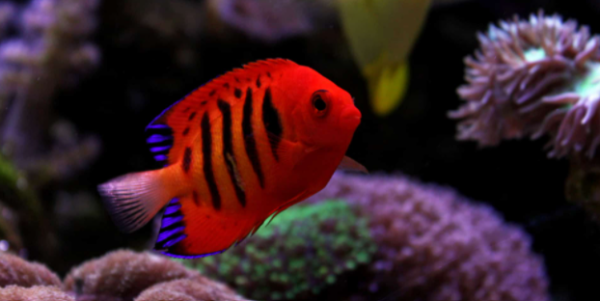
Saltwater plants are recommended to offer visual appeal to the tank while also regulating the water’s properties. We’ve compiled a list of the best saltwater plants:
- Green Finger Algae
- Mermaid’s Fan
- Tufted Joint Algae
- Dragon’s Tongue Algae
- Halimeda
Decorations For Flame Angelfish Tanks
Flame angelfish feel most secure when housed in aquariums with plenty of hiding places and plenty of algae to nibble on. You can choose between a sandy or gravel tank bottom for the substrate. It eventually relies on your aquarium’s other tankmates.
Lighting For Flame Angelfish Tanks
Moderate illumination is the most pleasant for these fish. The tank mates determine the water’s movement.
Nutrient Requirements for Flame Angelfish Tanks
The specific gravity ranges from 1.020 to 1.026. (1.025 is ideal)
To give your angelfish a good quality of life, use the following water chemistry:
- Alkalinity: 0
- Nitrite: 0
- Nitrate: less than one part per million (ppm) or near to zero
- Phosphate concentrations range from 0.13 to 0.2 parts per million.
- Calcium levels range from 350 to 420 parts per million.
- Magnesium levels range from 1250 to 1300 parts per million.
- 0.06 ppm iodine
- 8 to 10 ppm strontium
- 0 copper (lethal to angelfish)
Feeding Flame Angelfish
The flame angelfish feeds on small creatures (very small, observable only on a microscope) found in the substrate and the algae it encounters. We can offer them, like food, nautics of living artemia, before getting used to various types of frozen food in the aquarium. Also, this fish will adapt more easily to an intervertebral aquarium.
After that, it will not be too hard for the fish to get used to the dry food that we find in the aquarium stores. The last recommendation: When purchasing, choose only healthy specimens and, as far as possible, already acclimated, which will allow you to easily overcome some obstacles to maintaining and feeding this type of fish.
Best Diet for Flame Angelfish
Flame Angelfish are omnivores, meaning they eat both animals and plants. Frozen marine foods, live foods, and flake foods appear to be their favorites.
If the rate of development on live rock isn’t keeping up, it’s a good idea to supplement their diet using dried algae. It will keep any nutritional problems at bay.
Spirulina and Mysis shrimp and numerous commercial angelfish meals available at most pet stores are wonderful choices.
How Often Should You Feed Flame Angelfish?
Only feed your Angelfish as much food as they can consume in 2 – 3 minutes, up to two times a day. Too much food could deplete the tank’s nutrition and put the fish’s lives in jeopardy. Furthermore, overeating serves no purpose for them in any manner. They also produce bioload, which impacts the water’s quality.
If the angelfish are still young, you should feed them more frequently and in smaller volumes. They cannot consume a big amount of food in one sitting, necessitating more feeding sessions.
Many aquarists report that their younger angelfish die due to weakened immune systems.
Not feeding your angelfish is a typical blunder. They’re simply grazing. Many flame angelfish graze for a small amount of food and spend almost as much time looking for it. It is often beneficial to their health to feed them twice a day.
Flame Angelfish Behavior and Temperament
When you first put the Flame Angelfish in your tank, it will be shy and withdrawn. You must offer your Flame Angelfish with a tank that closely resembles their native habitat if you want them to adjust to their new surroundings quickly.
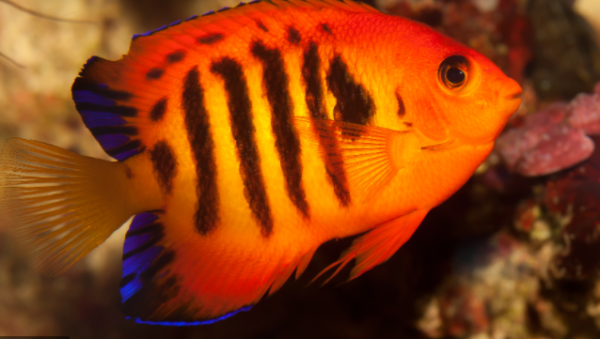
They are non-aggressive and get along with a wide variety of species. They become more hostile when housed in the same tank as their conspecifics and species. Upwards of one Angelfish in a tank necessitates a more complex task. The high levels of hostility between two angelfish will be difficult to control.
When choosing tank mates, consider that Flame Dwarf Angelfish will prey on smaller, more docile fish species. You should aim to identify tank mates who are similar in size and behavior. Fish with similar moods will get along fine — or at least stay out of each other’s way.
Are Flame Angelfish Lone or Societal in Nature?
Flame angelfish are lone by nature and only like to socialize during the courtship.
Flame Angelfish Tank Mates
The general norm is to use a larger tank when introducing new fish. Never put two male Dwarf Flame Angelfish together because they will fight. If their tank isn’t at least 100 gallons, they’ll continue to bother each other.
They can be housed in couples with invertebrates and corals, as previously stated, albeit they will nibble at clam mantles, corals, and other invertebrates. Feeding the fish their favorite food groups will help reduce the amount of damage done to them.
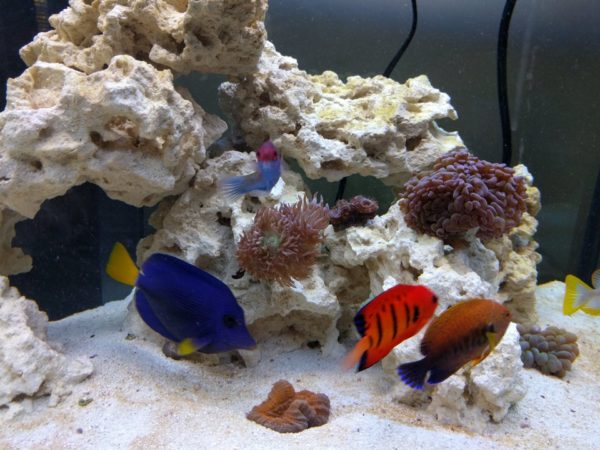
Ideal Flame Angelfish Tank Mates
Similar sized semi-aggressive species, such as the following, make good tank mates:
- Anthias
- Clownfish
- Tangs
- Large Wrasses
- Dotty back
- Dwarf angels
Bad Flame Angelfish Tank Mates
Some tetras and barbs are extremely poor tank mates for flame angelfish as they are all aggressive by nature.
Try to introduce small tank mates when the flame angelfish is still young. This will make it less likely for the angelfish to see other fishes as food.
Breeding Flame Angelfish
Breeding fire angelfish can be done in large-scale aquariums; it rarely occurs, but it happens, and raising the fry is the biggest concern about breeding them. For an amateur aquarist, the mission is more difficult because it will have to have a tank with enough capacity to accommodate more individuals. As has been found, along with the experiments so far, the two partners climb to the surface, where the female expels the eggs, which are then immediately fertilized by the partner. The breeding process itself is not an obstacle to Centropyge loricula. Unfortunately, however, fry growth has not been successful because of the difficulty of feeding them.
Flame Angelfish are extremely difficult to breed. On the other hand, these fish have hatched in captivity and been successfully raised by lucky aquarists.
Flame Angelfish are the spawning fish that rise via the water column at dusk, producing a cloud of eggs and sperm. Maintain as deep a tank as feasible to enhance spawning. To create a normal day-night diurnal atmosphere, use illumination. Turn off half of the aquarium lights, then come back 2 hours later to switch off the rest. You must do this every day at the same time.
It takes roughly 24 hours for fertilized eggs to hatch. Angelfish fry prefers tiny algae as a feeding source.
Flame Angelfish Breeding Level – Hard
Flame Angelfish Sexual Dimorphism
Since the Flame Dwarf Angel is a sexually dichromatic species, men and females are easily distinguished. Males, for example, have more noticeable blue stripes on their anal and dorsal fins than females.
Flame Angelfish Common Diseases and Their Treatment
The infections that affect Flame Angelfish are the same as those that affect other marine fish. Fungal, parasites, bacterial diseases, and physical injuries are the two main categories of illness.
Diseases Caused by Protozoa and Parasites
Parasites like White Spot Disease and Marine Velvet Disease, two of the most frequent diseases, affect dwarf angelfish species.
Both of these external parasites are treated in essentially the same way.
Begin by heating the water to roughly 820 degrees Fahrenheit. The parasite’s lifecycle will be disrupted, and it will not attach itself to the fish. As a result, any free-swimming parasites will be successfully destroyed before they can harm the fish.
You should also dose the tank with an appropriate over-the-counter preparation from a reputable fish retailer.
Treatment of parasites in reef or marine aquariums with a live rock might be tricky. Many treatments use formalin, quinine, or copper, which are all toxic to other marine life. On the other hand, Metronidazole is a safe and effective procedure for a variety of anaerobic and protozoan bacterial infections.
Metronidazole works by inhibiting parasite multiplication, which, when combined with higher water temperature, is generally enough to end an outbreak in the tank.
Flame Angelfish are also sensitive to bacterial and fungal infections.
Often, these diseases develop due to an injury or parasite disease that causes damage to the fish. Vibrio bacteria are responsible for one particularly terrible bacterial illness. Vibrio bacterium can lead to deadly diseases such as Popeye, dropsy, red streaks, and skin bleeding. This is a fast-acting bacterial infection that can kill a fish in just a few days.
White Spot Disease
A parasite causes White Spot Disease by attaching itself to a fish’s skin and causing inflammation. Affected fish will be seen flicking or rubbing their bodies on a substrate or perhaps against tank decorations and structures.
Marine Velvet
A swimming parasite adheres to the fish’s body and causes Marine Velvet.
The fish’s body is covered in a light brown to yellowish “dust” as a symptom. Respiratory discomfort, clamped fins, and hazy eyes are signs of a sick fish. Due to the parasite’s itchiness, infected fish may also glare off the substrate or even tank ornaments. The fish will have a low appetite and may start to lose weight.
Bacterial Diseases
The flame angelfish are also sensitive to bacterial and fungal infections.
Often, these diseases develop due to an injury or parasite disease that causes damage to the fish. Vibrio bacteria are responsible for one particularly terrible bacterial illness. Vibrio bacterium can lead to deadly diseases such as Popeye, dropsy, red streaks, and skin bleeding. This is a quick-acting bacterial infection that can kill a fish in just a few days.
Bacterial Disease Treatment
Placing the fish in a freshwater plunge is among the most effective ways to kill bacterial illnesses.
If there are no signs of stress, make sure the water temperature and pH are the same as in the marine tank, then immerse the fish in the water for 15 minutes. You can also treat the entire tank with an over-the-counter solution.
Minor injuries to fish can happen due to being nipped or bullied by a tankmate or during the spawning process. A bacterial infection is the most serious risk of a physical injury.
If your Flame Angelfish gets hurt, it’s a good idea to disinfect the tank using an antibacterial substance as a preventative measure.
Small Buying Guide
If you decide to go and buy one of them, it is ideal that you ask your provider (the aquarium shop staff or the person you are buying it from) to give you a well-adapted specimen that is already acclimated the tank life. And you must make sure that you buy a healthy fish that is not prone or does not carry any diseases that can affect the other inhabitants of the tank you want to put it in.
Ideally, after the fish has been bought, it is recommended that it stays in a quarantine tank for 1-2 weeks. It applies to all fish bought, whether purchased from a retailer or from a person you know. After 1-2 weeks of quarantine, the fish can be safely introduced into the community tank.
Facts About Flame Angelfish
- Flame angelfish is an extremely rare species.
- They have 5-7 years or sometimes more when in the wild.
- Flame angelfish are semi-aggressive and can be territorial.
- They are super-fast growers and attain full size in about two months.
Are Flame Angelfish Right for You?
Flame Angelfish are the simplest way to improve the appearance of your tank because they bring so much visual interest. They’re interesting to look at and could be deemed reef safe. If they choose to go after the invertebrates, you may remove them.
FAQs
Is It Safe to Keep Flame Angelfish on The Reef?
For the most part, Flame Dwarf Angelfish are reef-safe, although no two are alike, and some may choose to peck at delicate mushy polyps.
Flame Angelfish have been known to attack and devour coral structures, leading to their removal from the tank in some situations. However, those instances are uncommon.
It all boils down to your Flame Angelfish’s personality in the end. Yours might enjoy the reef and won’t attack it.
Are Flame Angelfish Aggressive?
Flame Angelfish are normally calm fish, but their hunting impulses are triggered when they see smaller, more docile fish. When adding tank mates, this is a crucial rule to remember.
Semi-aggressive tank mates with similar sizes are ideal. Just don’t put aggressive fish in with your Flame Angelfish because they can mistake them for prey and swallow them whole!
What Is the Best Place to Buy Flame Angelfish?
Flame Angelfish are available for purchase at most pet stores, online businesses, and online forums. They’re a little pricey, starting at $80 and going up. The final cost is determined by the fish’s size, availability, and location.
Look for individuals eagerly hunting for food and are reasonably alert when purchasing Dwarf Flame Angelfish. When startled, they should be difficult to grab and curious. They’ll quickly emerge from their hiding location to survey their surroundings.
Conclusion
It is a semi-aggressive species and will be kept with sturdy fish of the same size and behavior. Care should be taken because they can pinch soft corals and are not recommended to be kept together with timid organisms. It is an active fish that will spend most of its time looking for food among stones and other aquarium objects.
In some cases, the flame angelfish has been reported to attack and eat coral structures by some aquarists, and for that reason, they decided to remove it from the tank. But those are rare cases, and each has its personality; yours may like the corals and not attack them.
The flame angelfish has long been considered a sustainable choice for the aquarium. (Unfortunately, in the last few years, some specimens did not survive for more than a month; the reason for this mortality is unknown, although some aquarists suspect problems related to collection and transport).
Overall, these fish are simple to feed, hardy, and require basic maintenance that won’t break the bank. Simply prepare to invest in a sufficiently large tank, and you’ll be OK.
Please don’t hold your breath on breeding Flame Angelfish; they’re not easy to keep and require a lot of resources for most people.
